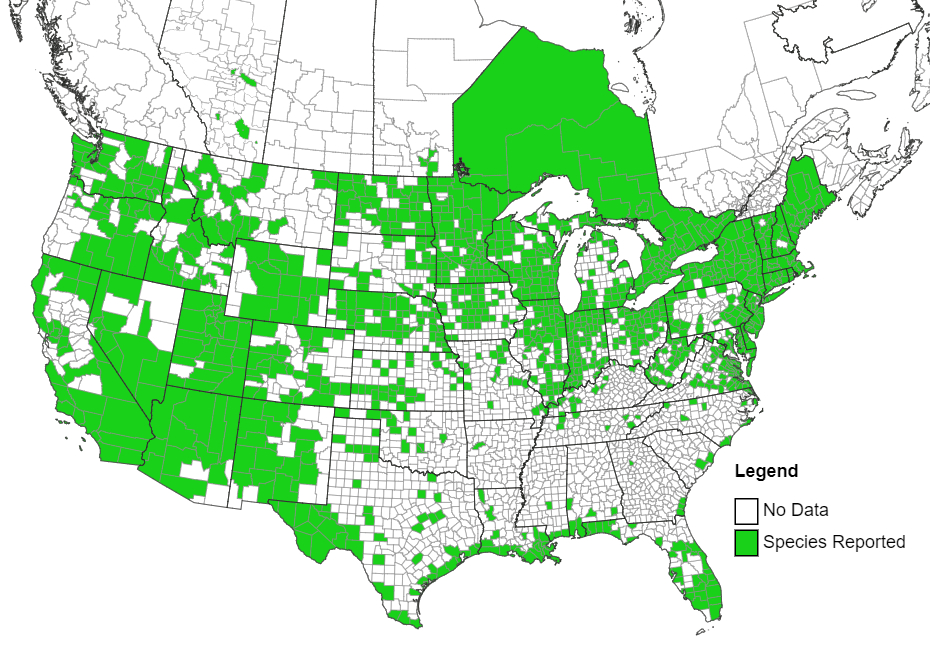MENU:
Where is Phragmites Found?
Non-native Phragmites, or the common reed, can now be found in all of the lower 48 states of America and many Canadian provinces. It colonizes natural wetlands throughout the continent, but also human-made habitats such as roadsides and agricultural ditches.

North American distribution of Phragmites australis as reported by EDDMapS users as of February 2022. (EDDMapS. 2022. Early Detection & Distribution Mapping System. The University of Georgia – Center for Invasive Species and Ecosystem Health).
Non-native Phragmites (Phragmites australis subsp. australis) is now the dominant subspecies of Phragmites throughout the eastern parts of United States and Canada, while the native Phragmites (Phragmites australis subsp. americanus) is scattered across its historical distribution and mainly confined to natural wetlands. There are three lineages of Phragmites found in North America, and there is significant overlap in the approximate ranges of the native and introduced lineages (see maps below). Due to this high degree of range overlap, it is important to determine what lineage of Phragmites you are dealing with (see our identification resources here).

Range maps of the native Phragmites (Phragmites australis subsp. americanus), Gulf Coast Phragmites (Phragmites australis subsp. berlandieri, endemic to North America), and introduced Eurasian Phragmites (Phragmites australis subsp. australis) lineages identified by Saltonstall (2004).
Non-native Phragmites is likely to be found in disturbed and linear habitats such as roads, dikes, and ditches.
This has been attributed to a broader tolerance to a variety of environmental conditions such as salinity level, soil type, nutrient levels, and heavy metals. Movement of non-native Phragmites through these disturbed areas appears to facilitate spread.
- Roads increase the level of landscape connectivity, thus facilitating the transport of propagules (i.e., seeds, plant fragments) from invaded to non-invaded wetlands. Roadsides are harsh environments frequently disturbed and with high inputs in salts and contaminants which favor the establishment of disturbance-adapted plant species such as non-native Phragmites.
- Drainage ditches and canals facilitate spread by providing favorable habitats and by facilitating the dispersal of vegetative parts to downstream areas during floods or other disturbances.
- Agricultural areas commonly have high levels of non-native Phragmites due to soil disturbance and high nutrient levels from fertilizer run-off.
Non-native Phragmites is limited by water depth
Water levels have been identified as one of the very few limiting factors of non-native Phragmites. High water levels and continued flooding may successfully limit the spread of non-native Phragmites. Check out this interactive USGS StoryMap showing the influence of high-water levels on Phragmites stands in the Great Lakes for more information. While the water level tolerance of non-native and native Phragmites has not been yet compared, studies of large- and small-scale patterns of distribution demonstrated that native Phragmites is more frequently observed near rivers and wetter marshes.
Report your sighting!
To report and share your Phragmites sightings or see where Phragmites has been detected in your area, visit our Mapping and Monitoring Tools page.
Resources
- Lindsay, D.L., X. Guan, N.E. Harms, J.T. Cronin, L.A. Meyerson, and R.F. Lance, 2023. DNA assays for genetic discrimination of three Phragmites australis subspecies in the United States. Applications in Plant Sciences, p.e11512. (Open Access)
- Catling, P. M. and S. Carbyn. 2006. Recent invasion, current status and invasion pathways of European Common Reed, Phragmites australis subspecies australis, in the Southern Ottawa District. Canadian Field-Naturalist, 120(3): 307-312. Abstract
- Lambert, A. M. and R. A. Casagrande. 2006. Distribution of Native and Exotic Phragmites australis in Rhode Island. Northeastern Naturalist, 13(4): 551-56. Abstract (Visit Dr. Lambert publication page to obtain a copy)
- Meadows, R. E. and K. Saltonstall. 2007. Distribution of native and non-native populations of Phragmites australis in oligohaline marshes of the Delmarva Peninsula. Journal of the Torrey Botanical Society, 134(1): 99-107. Abstract
- Taddeo, S. and S. de Blois. 2012. Coexistence of introduced and native common reed (Phragmites australis) in freshwater wetlands. Ecoscience, 19(2): 99-105. Abstract (Visit the Phragmites research group website to request a reprint)
